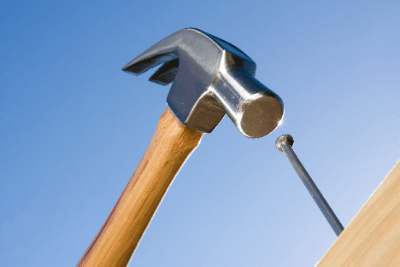What Is a Nail Hammer?
 A nail hammer is a type of hammer and is the general term for hammers used to drive nails (nails). The center of gravity of the head is on the striking side, which prevents the hand from shaking when driving in nails.
A nail hammer is a type of hammer and is the general term for hammers used to drive nails (nails). The center of gravity of the head is on the striking side, which prevents the hand from shaking when driving in nails.
On the opposite side of the hammering side, there is a nail puller like a crowbar. The center of gravity is more in line with the striking side than that of a hammer, which is a similar tool.
A similar tool is the temporary frame hammer. It is designed for removing nails from thick wooden frames and has a long handle. For general work, nail hammer is more commonly used because they are easier to handle.
Uses of Nail Hammers
Nail hammers are used in a wide range of situations. They can be used in two ways with a single hammer: driving in nails and pulling out nails that have been missed. This tool is used for “crafts” and “DIY” work at school, and even by professional craftsmen.
As a nailing tool, it is used in tasks involving a lot of wood and plastic. For example, it is frequently used in “house construction” and “DIY” situations.
Conversely, it is also used in “demolition work,” where the nail removal section is utilized to disassemble materials that are joined by nails. Using the principle of leverage, nail hammers are used to pull out not only common nails but also double nails and splints.
How to Select Nail Hammers
- Head Shape
The head should be about 3 to 4 times the size of the nail to be hammered. Stone or wood, the base of the nail, may be softer than the material being hammered. Therefore, a hammer with a hammering face larger than the object will strike the material around the nail, causing unevenness and damage. - Overall Length
Overall length is broadly classified into three categories: less than 8″, 8 to 11″, and 11″ or longer. A longer overall length delivers a stronger blow, and the shorter the length, the lighter and easier to handle. It is important to select a size that matches the user’s body shape.
The shorter the length, the easier it is to store. On the other hand, longer lengths have the disadvantage of being difficult to handle. Furthermore, when using a nail that is vertically positioned from the ground, such as on a wall, it is difficult to apply force, which may cause a nail to fail to hit the ground. - Material (hardness)
Carbon steel (S45C) hardened, carbon steel (S-45C) mirror polished (mirror finish), and TPE (thermoplastic elastomer) are used. For metals, quenching will increase strength and durability. - Grooves on Striking Surface
There are two types: one with grooves and one without grooves. The grooves prevent the nail from slipping when it comes in contact with a nail, increasing the possibility of the blow being transmitted to the nail.
On the other hand, the absence of grooves has the advantage that when a nail bites into a material, the striking surface does not leave marks on the material. - Handle Material
Wood has the advantage of less recoil and less numbness in the hand when a nail is driven hard. On the other hand, steel pipes tend to transmit vibration to the hand, but are highly durable. On the other hand, fiberglass is lightweight, easy to fit in the hand, and hard to slip out, making it suitable for beginners.